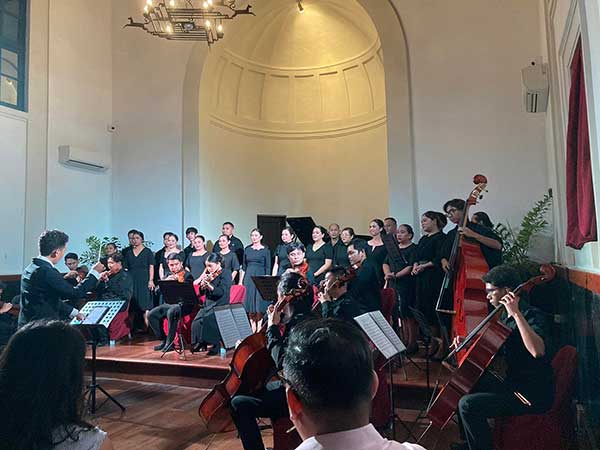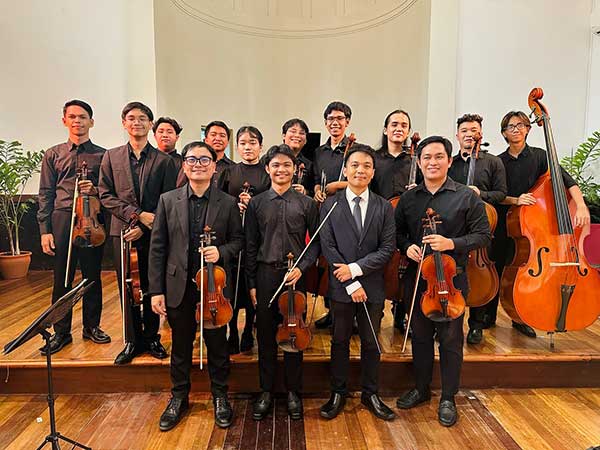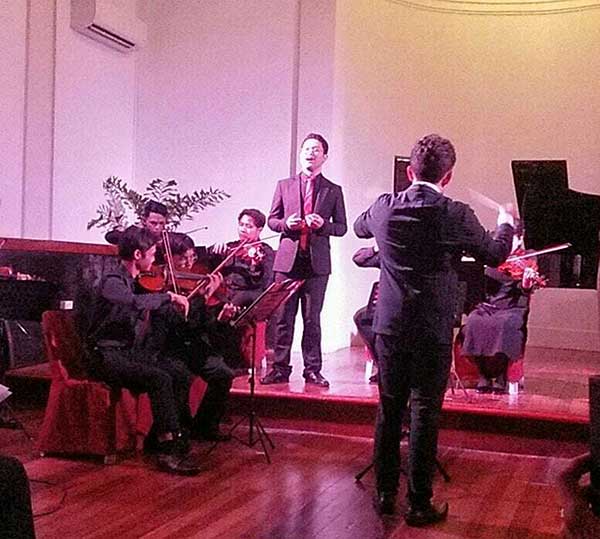By John Anthony S. Estolloso
COMMUNITY ORCHESTRAS, like all enduring institutions great and grand, are built from the grassroot desire of a communal musical experience, one that is shared by both performers and audiences alike. Motley and meagre may be their beginnings, their development serves as milestones of a community’s musical aspirations, and perhaps, it also bespeaks of a refinement of musical tastes.
The afternoon and evening of August 21 gave credence to that sentiment – or balatyágon, as the title of the concert aptly denotes: the Iloilo Community Orchestra, augmented by a combined chorale of two choirs, stepped up to the occasion with their inaugural concert. Regaling the crowd of Ilonggo music enthusiasts who have been clamoring for so long for an orchestra they can claim as their own, the musicians showcased the best that locally honed talent and technical musicality can offer; needless to say, the standing ovations at the end of the fledgling performance was certainly beyond the ordinary.
While comprised only by string players, the group’s mastery of technique and the hours of rehearsals were very much evident. It took ten years of planning and false starts, and it was apt that the opening pieces of the concert are evocative of the stately though assured andante of the orchestra’s baby steps. Sibelius’s ‘Andante Festivo’ was a good warm-up for the musicians: most striking was the clarity of their phrasing, something that prominently surfaces and is most discernible in these slow movements.
The four pieces that followed were cut to the same tempo: Schumann’s ‘Choral’, Haydn’s ‘St. Anthony’s Chorale’, the caprice from Gluck’s Alceste, and Sato’s ‘Going Home With You’ have an elegiac quality in the playing, the slow, measured notes stretched in languid yet clear phrases, the harmonies sharp, altogether evoking a poignant pathos in the performance.
Mozart’s “Ave verum” was a fitting finale for the first segment. With the Iloilo City Government Chorale and the Baganihan Singers intoning the old Latin communion hymn, the delivery was a worthy paean to its composer. Without discounting the gravitas of the hymn’s lyrics, the music itself – and its performance – was soulfully profound: it flaunted Mozart’s De profundis, the composer pleading for divine absolution a few months before his demise.
Lending more majesty and grandeur to the stringed instruments was the power of human voices singing in harmony. With Mr. John Michael Lauron conducting the singers, the combined choirs performed prayerful a capella arrangements of Eslabra’s ‘Amay Namon’ and Bryan Adams’s ‘Heaven’. Harking back to the native, the Itneg victory chant ‘Iddem-dem Mallida’ was delivered with much vocal vigor, a rollicking, rhythmic chanting heavily accented by the stomping of feet on the hall’s wooden floors.
Stealing the spotlight was Jomel Garcia’s sweeping rendition of Morricone’s ‘Nella Fantasia’. No microphones were necessary – the power and tenor of his voice was enough to capture the audience’s sensibilities, despite the Italian lyrics of the song. It is worth noting here that the melody from the alluded film score was not lost to the more perceptive listeners, enough to recall images of religious missions amidst a howling wilderness.
The latter part of the programme was markedly an exploration of the group’s virtuosic desires. Jenkins’s ‘Palladio’ is a contemporary favorite, with its sharply agitated accents and rhythmic passages. The evocative strains of Elgar’s ‘Nimrod’ from his Enigma Variations seemed to conjure images of ‘England’s green and pleasant lands.’
Sharply contrasting the modern and the foreign was Prof. Taton’s arrangement of ‘Sa Tuburan’, the Ilonggo song arranged for a string orchestra, almost giving it the tang of a Castilian folk-tune. Capping these selections was a rousing performance of Lubasan’s Dakbanwa, the familiar hymn of the city as arranged for choir and orchestra.
So how do you end a debut concert already brimming with mesmerizingly promising talents? With a cute pizzicato piece by Leroy Anderson. Requiring some clapping and onomatopoeia from the enthusiastic audience, the raggedy ending of “Plink, Plank, Plunk!” evoked laughter from everyone inside the performance hall, but the composer would not have given a fig about it: it was ragtime after all.
* * * * *
With Prof. Jose Taton Jr. setting the direction for this musical endeavor and under the masterful baton of young Mr. Luis Rabut IV, the Iloilo Community Orchestra is off to a good, albeit slow, start; Mr. Arqzaend Andrade as concertmaster is more than capable as the lead violinist. It goes without saying that we all look forward to the next performance of the orchestra.
If by any chance you have an acquired affinity for the viola or cello, or some long-fallow romance with other musical instruments, perhaps you will find some reignited spark of passion to join the orchestra and be part of its musical journey: it still has great need for local talents to swell its ranks. Heed the Orphean call and give in to its musical allures; to paraphrase the Bard, play on and give us excess of it.
[The writer is the subject area coordinator for Social Studies in one of the private schools of the city. The photos are from Allyn Canja, Lex Legaspi, and Vic Salas.]
























